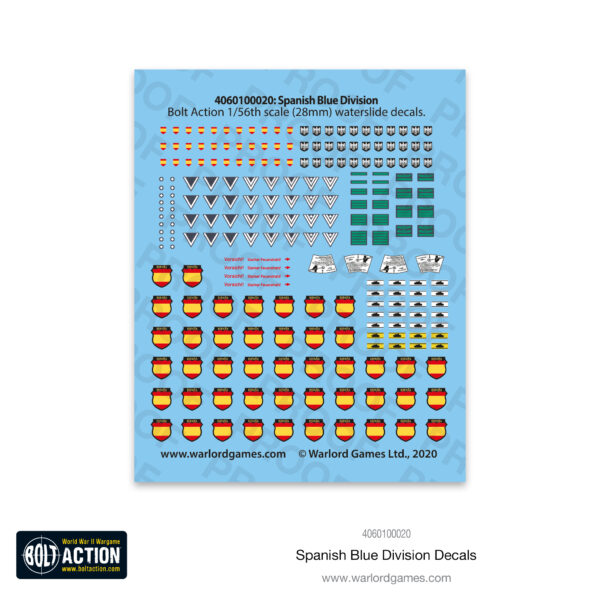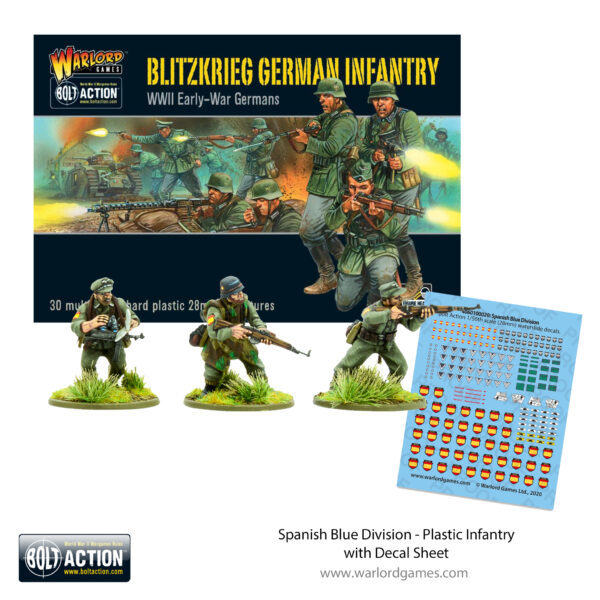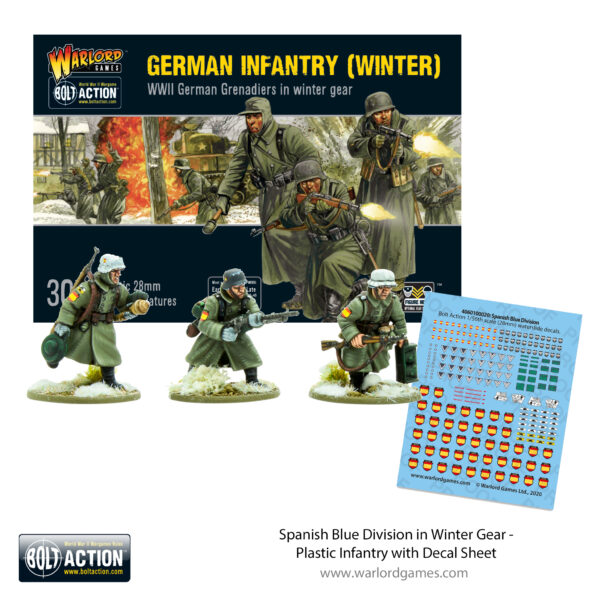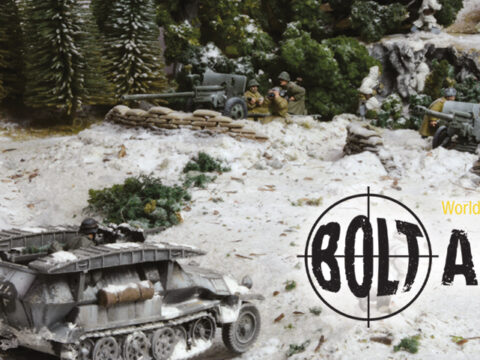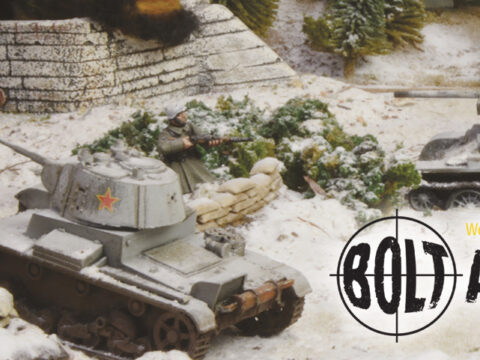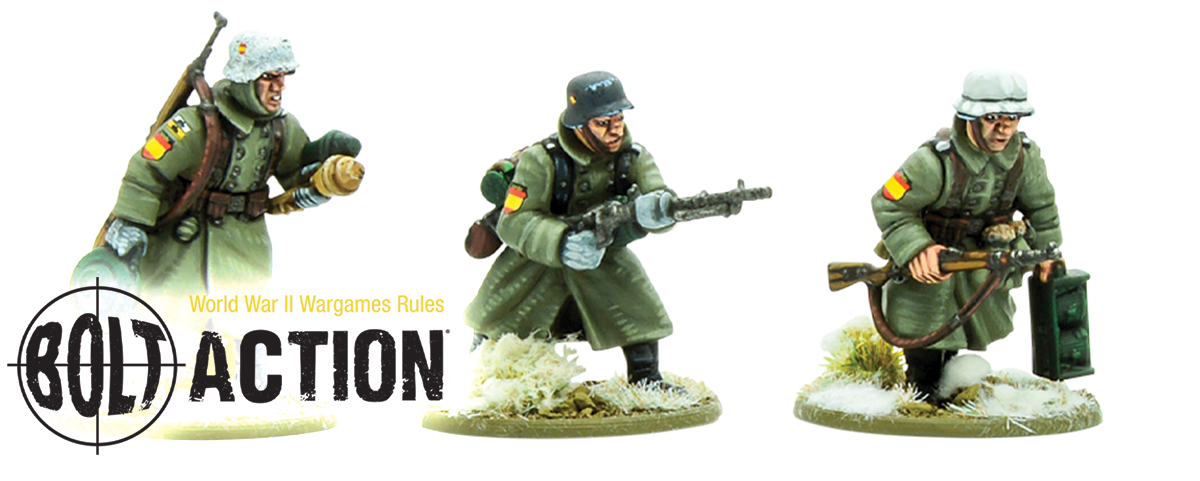
This article from Robert Martin examines the background and history behind the Battle of Krasny Bor, part of the Siege of Leningrad, that took place over the 10th and 11th of February 1943. The article contains general guidance for players looking to fight these battles in Bolt Action and details the forces involved. Also included is a new theatre selector allowing you to use the Spanish Blue Division in your games.
Army Group North
On 8th September Army Group North captured Shlissel’burg on the South coast of Lake Lagoda and thus severed Leningrad’s last remaining overland link with the rest of Russia.
German Plans
The Germans decided to besiege Leningrad and starve it into submission, thus avoiding a costly urban battle and allowing most of Army Group North’s panzers to be reallocated to Army Group Centre which was driving on Moscow.
1942
The inadequately prepared Russians suffered during the winter of 1941/ 42 but the city held on as the Russians were able to get food and military supplies into the city across the frozen lake Lagoda. As the Ice melted and winter turned to summer the Russians withdrew most of the surviving civilians and used fleets of barges to maintain the tenuous supply line.
The siege dragged on, Army Group North was never given the resources to storm the city as Hitler prioritised the advance of Army Group South towards their destiny at Stalingrad. The Soviets launched several unsuccessful attempts to relieve the city.
1943 – Operation Spark
In January 1943, with German attention and resources diverted to the attempted relief of Sixth Army in Stalingrad the Soviets sensed an opportunity to finally break the siege of Leningrad. General Zhukhov launched Operation Iskra (Eng: Spark) which succeeded in formally breaking the siege of Leningrad by opening a five-mile wide land corridor along the southern coast of Lake Lagoda. The victory was incomplete however as the corridor was still dominated by the German-held heights of Sinyavino to the south, the Germans were thus able to interdict Soviet traffic with artillery fire and raiding parties.
The Battle of Krasny Bor
Russian Plans – Operation Polar Star
Zhukov decided to launch a two-pronged attack called operation Polyarnaya Zvezda (English: Polar Star), aiming to trap the bulk of the German 16th and 18th Armies in the siege lines to the south of Leningrad. The northern attack by the Volkhov and Leningrad fronts was to be launched first with the intention of drawing German reserves away from the more important southern thrust by the Soviet North West front.
Krasny Bor Plans
On 10th February 1942, the Soviet 54th and 55th Armies were to attack across the frozen landscape. The 55th Army would make up the right pincer, smash through the 250th Spanish Division on the Leningrad front and then drive on Tonso where it would meet the 54th army which was to make up the left-hand pincer and drive through the German XXVIII Army Corps on the Volkhov front.
The Right Pincer
The 55th Army was to attack South-East from Kolpino on a 14km front; on the flanks, the 43rd and 72nd Rifle Divisions were to launch spoiling attacks whilst the main thrust was in the centre where the 63rd Guard Division was supported by twenty-one KV1 of the 31st Guards Tank Regiment. Once a breakthrough had been achieved the 35th Ski Brigade, supported by T34s from the 122nd Tank Brigade were to drive South West to Krasny Bor. The attack was to be preceded by an intensive two-hour preliminary bombardment from a thousand Katyusha rocket tubes, mortars and artillery guns.
German Defensive Tactics
Army Group North lacked sufficient troops to form a continuous trench line or adopt defence in depth; as a primarily infantry force it also lacked the mobility needed for a fluid mobile defence. The Germans thus held their front with scattered strong-points. The first two to three Kilometres behind the front line was designated the “security zone” and contained platoon and company-sized strong-points equipped with Machine Guns and Mortars, behind these were well-camouflaged battalion strong-points surrounded by mines and barbed wire and equipped with artillery, anti-tank guns and some of the few available Stugs and tanks.
The depth of the German positions meant the Russians would become bogged down reducing the strong-points and thus the Germans would have time to call in counter-attack units from adjacent sectors or the small army reserve, the counter attackers were to encircle the attacking Russians and thus regain the lost ground.
Russian Offensive Tactics
Russian offensive tactics were still unsubtle and usually depended on mass rather than manoeuvre. By the start of 1943 the Russians had a large artillery arm and a strong air force, both of which would be used to launch preliminary bombardments prior to attacks going in. Attacks would normally be conducted by massed infantry formations, supported by tanks if possible. At Krasny Bor the Russians concentrated most of their twenty-one KV-1 heavy tanks in the centre with the 63rd Guards Rifle Division. Once a breach had been made Russian reserves would swiftly move through and attempt to exploit to the rear. At Krasny Bor the reserves were the ski troops of 35th Ski Brigade supported by 122nd Tank Brigade’s T34 tanks. The massed Russian infantry was vulnerable to German artillery fire and thus the Russians suffered heavy casualties as they pushed towards the German rear.
The Terrain South of Leningrad
The terrain south of Leningrad was mostly relatively flat open steppe farmland with the odd area of woodland, thus a Bolt Action game set in this area should be fought on a board mostly devoid of cover.
The Russian Weather
By January 1943 both sides were equipped for the Russian winter thus the effect of the extreme conditions was mostly mitigated. During in the winter the ground froze hard and should be treated as open ground, during the spring the meltwater made the area very muddy, and even the roads became impassable. For most of the year wheeled vehicles could only operate on the roads, and even these were impassable in the spring.
Players may wish to use the Snow, mud, Ice and Frostbite rules from page 99 of the Ostfront supplement as appropriate to add a bit of flavour to the game.
German Defensive Positions
The Germans constructed prepared positions and thus the Dug-In Rules from page 102 of the Ostfront supplement should be used. The Germans usually surrounded their defensive positions with barbed wire and minefields; use the Minefield rules from page 105 of the Ostfront supplement and the Barbed Wire rules from page 89 of the Germany Strikes supplement.
Krasny Bor
On the 8th February an attack by a division of the Soviet 55th army captured some Spanish outposts but also alerted the Spanish to the forthcoming offensive. The Spaniards had detected the Soviet build up and had thus improved their defensives and received some German crewed PAK 40 from army reserve. Army and divisional reserves were brought to readiness in order to conduct any necessary counter attacks or to seal any breach in the line. The Spanish troops dug in and awaited the inevitable preliminary bombardment.
Day One – Wednesday 10 February 1943
The Soviet 55th Army fired a two-hour bombardment before launching their infantry and tanks forwards at 8am on the 10th February.
The Spanish Left
On the western edge of the battle, the infantry of the Russian 72nd Rifle Division overran the Spanish 250th Reserve battalion but were repulsed by the 3rd Battalion of the 262nd Spanish regiment on the far left.
The Spanish Right
The 1st Battalion of the 262nd Spanish regiment managed to initially repulse the attack of the 43rd Russian Infantry Division but was later almost encircled and the few survivors were forced to retreat southwards.
The Centre
The 63rd Guards Division and their supporting KV1 tanks advanced in the centre. The Spanish were well dug in but had suffered from the bombardment which had created several gaps in the line which the Russians and were quick to exploit. The remaining Spaniards were unable to retreat and most fought to the death.
The 3rd Company of the 1/262 held the October Railway embankment and managed to repulse several infantry and armoured attacks before the forty survivors finally abandoned the position and retreated into the village just after midday.
Having overwhelmed the Spanish front line the Russians pushed into Krasny Bor. Spanish artillerymen and engineers held the village but were gradually destroyed by the Russians, the survivors withdrawing at night.
Day Two – 11 February 1943
On the 11th February a Kampfgruppe composed of elements of the 4th SS (Polizei) Division supported by the three Tigers and three Panzer III of Schwere Abeiltung 502nd counterattacked into the Russian flank.
More vicious fighting resulted, the Tigers being especially effective, thirty-two Russian tanks were destroyed and the Russians forced back, but the Germans were now exhausted and had run out of reserves, they called off the attack and both sides paused to lick their wounds.
Krasny Bor was a victory for the Spanish and Germans, the Russians had failed to encircle and destroy any significant German or Spanish formations. Both sides had suffered casualties, the Russians lost considerably more men than the Germans, but the Red Army still had large manpower reserves to call upon, whereas the Heer was already having to fill its ranks with foreign volunteers and call up younger and older Germans.
Russian Forces
63rd Guard Division
Following the success of operation Spark several Russian units were re-designated as Guards Units, amongst them was the Russian 136th Rifle Division which was re-designated as the 63rd Guards Rifle Division on 19th January 1943. The 136th had been formed from the 8th Rifle Brigade which had fought the Finns in the Hango peninsular from June to November 1941. The brigade was withdrawn to Kronstadt and expanded into the 136th Rifle Division in 1942. The 8th Rifle Brigade’s commander, General Major Nikolai P. Simoniak commanded the elite 30th Guards Rifle Corps which launched the attack on Krasney Bor. After Krasney Bor the 63rd Guards Division fought in Estonia and Kurland.
German Forces
250th “Blue” Division 250. Infanterie Division or División Española de Voluntarios
The German 250th “Blue” Division was in the path of the intended Soviet attack near Krasny Bor. It was formed from Spanish volunteers in late 1941 after Hitler accepted an official offer of help from Franco. About half the Officers and NCOs were professional soldiers on leave from the Spanish army, most of the other volunteers had fought in the Spanish civil war. Whilst most were Falangists some were former republicans who volunteered in order to demonstrate their loyalty to the new regime or in order to save themselves or their relatives from prison.
The Division maintained its national identity but was trained, uniformed and equipped by the Germans, thus the troops looked like any other Wehrmacht soldier’s. In the winter of 1942 / 43 they were wearing winter uniforms and were equipped with German rifles, MGs, mortars and AT Rifles. The Anti Tank batteries were still equipped with PAK 36.
The Blue Division had gone into the line in October 1941 with Army group north near Volkhov. In August 1942 it was moved north and settled in to help with the siege of Leningrad.
The Division was shattered by the battle at Krasny Bor, many units had suffered 75% casualties and the Division’s morale dropped. It remained in position following the battle of Krasny Bor, its ranks filled with new drafts from Spain including some conscripts. The Division was finally disbanded in October 1943 when Franco gave in to pressure from the Spanish Catholic Church and the allies and recalled the Spanish volunteers. About 45,000 Spaniards served on the Eastern Front, 4,500 dying in the service of the third Reich.
4th SS “Polizei Division
The 4th SS “Polizei” Division was originally formed in 1939 from German policemen who retained their ranks and police status. After fighting in France and Russia, it formally joined the Waffen SS in February 1942; the policemen officially became soldiers at this time and also adopted SS insignia. It was an infantry Division at the time of Krasny Bor.
Schwere Panzerabteilung 502
Schwere Panzerabteilung 502 deployed to the Leningrad front in August 1942 and was the first unit to use the Tiger I in anger on 16th September (26 years and a day after the first use of tanks in World war one), it lost almost all its tanks during Operation Iskra, but the crews escaped. Following the battle of Krasny Bor it continued to serve on the eastern front until the end of the war (it was redesignated the schwere Panzerabteilung 511 in January 1945). It was one of the most successful tank battalions of the war, claiming the destruction of 1400 enemy tanks and 2000 guns.
Blue Division Force Selector
In early 1943 the blue Division was an experienced, all-volunteer, combat formation, which was properly dressed and equipped for the Russia Winter. Frontline troops should all be veteran. Support troops (artillerymen without guns, cooks, transport and administration personnel etc.) who found themselves fighting as infantry when the Russians penetrated into the Spanish rear areas should be represented as regular Heer infantry squads.
Blue Division Special Rules (these replace the normal German army special rules)
Hitler’s Buzz Saw
The Spanish used German made machine guns, in particular the MG42, which were vastly superior to their enemies and rightfully feared by Allied infantrymen. German light and medium Machine guns fire one extra shot. Note that this applies to all light and medium machine guns, both those carried by infantry units and vehicle mounted ones.
Until Extinction
The Blue Division’s motto was “Sin relevo posible, hasta la extinción“ (English: No possible relief, until Extinction), they were very stubborn fighters, at Krasny Bor surrounded Spaniards fought to the death. All Spanish infantry and artillery units can be upgraded to Fanatics at the cost of +2 points per man.
“Spaniards die on their feet, not hiding in holes like rats”
The Spaniards were reluctant to “waste” time digging or maintaining trenches, they also often walked around in the open within range of Soviet snipers. To reflect their contempt for cover, the enemy never suffer more than a -1 modifier to their roll to hit when firing at Spanish troops in cover, even if the targets are in hard cover.
Army List
1 Lieutenant – First or Second
2 Infantry Squads – Heer veteran infantry squads
Headquarters
0-1 Captain or Major
0-1 Medic team
Infantry
0-4 Infantry Squads: Heer veteran infantry, Heer Infantry squads, Heer Veteran Pioneer Squads
0-2 MMG teams
0-1 Mortar team: light, medium or heavy
0-1 Sniper team
0-1 Anti tank Rifle team
Artillery
0-1 gun from:
Anti-tank Gun: Pak 36, Pak 40
Artillery gun: light
Tanks, Tank Destroyers, Assault guns, Self propelled artillery and Anti Aircraft vehicles.
0-1 vehicle from:
Panzer III Ausf E, F, G, H, J, M or N.
Tiger1,
StuG III Ausf B, C, D, E or F
Marder I, Marder II, Marder III Ausf H or M
Article and Theatre selector provided by Robert Martin.
Replicating the Battle of Krasny Bor
In the coming weeks, we’ll be bringing you new linked scenarios (also from Robert Martin), to enable you to replicate the Soviet’s attempt to lift the siege of Leningrad, or to field the Spanish Blue Division in preventing it at all costs. Now available in the Warlord Webstore, you can purchase decal sheets, that can be used in conjunction with our German kits to field the Blue Division on the tabletop. Alternatively, we’ve created quick and convenient bundles to kickstart a Spanish Blue Division Bolt Action army.

